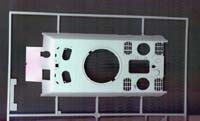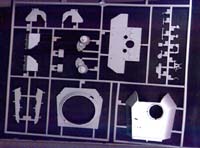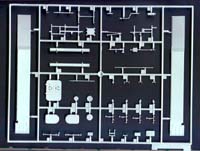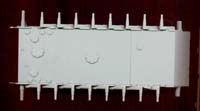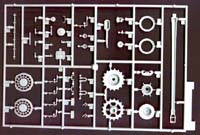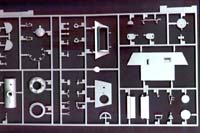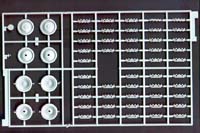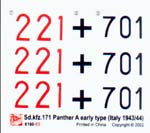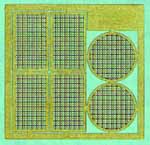DML DRAGON 1/35 Sd.Kfz. 171, PANTHER A, EARLY TYPE (ITALY 1943/44)
By Ray Mehlberger
KIT NO. 6160
|
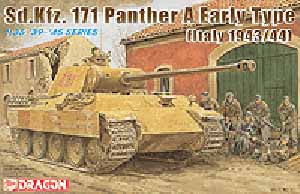 |
HISTORY
The German PANTHER tank entered service in 1943. The German Army had been rudely surprised by the appearance of the Soviet T-34 tank, and they carefully studied some captured samples. Hitler ordered the development of a similar vehicle, to weigh about 30 tons, and prototypes were developed by Daimler-Benz and Maschinenfabrik- Augsburg-Nurnberg (MAN). After some initial indecision the MAN model was selected for production, originally scheduled to begin in December 1942.
The first model was the Ausf. D version. It incorporated torsion-bar suspension with overlapping road wheels, sloped plates to deflect shot (a feature copied from the T-34), and a long 75 mm (2.95 in.) gun in the turret. No hull machine-gun was fitted, though a flap in the glacis plate could be opened to allow a machine-gun to be thrust through and fired. Production began in January 1943, but in April all issues were recalled for modification and it was not until May that the first examples reached service units. They were first used in action at Kursk in July of 1943. A total of 850 were produced before manufacture of this model stopped in September 1943.
The second series model was the Ausf. A. This had strengthened suspension, a better cupola for the commander and a ball-mounted machine-gun in the hull front. Numerous mechanical modifications were made to improve reliability. 2000 of this model were produced between August 1943 and May 1944.
Experience in the field brought several suggestions from the troops, and these were incorporated in the third series, the Ausf. G, production of which began in March of 1944. The hull side-armor was thickened, the driver's vision arrangements improved, armored ammo bins were fitted, and further mechanical improvements were made. Many later production models had better heaters fitted to improve comfort, and on some the gun mantlet was modified to stop the danger of shot being deflected downwards into the hull top. A total of 3126 of the "G" model were made and it was extensively used in every theatre of service in WWII.
The final model to be developed was the Ausf. F, though this NEVER went into production. The principal change was the adoption of a new turret known as the Schmal Turm (Narrow Turret), intended to provide a small frontal area. Thicker armor was provided, together with a mantlet capable of deflecting shot in any direction. An optical rangefinder was incorporated in the turret, and provision was made for up-gunning with an 88 mm (3.46 in.) gun in due course.
Various improvements were also made to the hull and running gear. Only eight hulls were ever completed and only three or four prototype turrets were made.
A number of late production Ausf. G models were built as Befelswagens (command tanks) in which the ammo storage capacity was reduced to make room for additional radio sets. These vehicles could be identified by their added antenna. A number of reworked Panthers were also converted into Beobachtungspanzers (artillery observation post tanks) in late 1944, in which the gun was replaced by a wooden dummy in order for extra radio equipment and artillery plotting boards to be fitted. The turret front was closed by additional armor plate, on which an additional ball-mounted machine-gun was placed. Some Panthers were also converted into Bergepanzers (recovery tanks).
WHAT'S IN THE BOX?:
The kit comes in a large lid and tray type box.
The cover art, done by our old friend Volstad, shows a Panther moving past a row of houses and a six man German infantry squad. It features square pattern Zimmerit. The side panel of the box shows three photos of the finished model.
The kit consists of 10 light gray styrene trees of parts, and four white vacuformed parts in eight cello bags. The instructions and decals complete the contents.
One immediately notices the instructions. They are printed in FULL COLOR! I really like this new look, because things seem a lot clearer than line drawings of parts. Now you have color images!
Large letter "A" tree holds the vehicle's top, rear plate, turret top & bottom, stowage bins, final drive transfer housings, jack, travel lock etc. (26 parts)
Large letter "B" tree holds the fenders, driver's vision flap parts, hatch covers, gun cleaning rod storage tube, tools & their brackets, & many miscellaneous small fittings. (42 parts)
Letter "C" part is the hull's bottom piece. The road wheel arms are molded solid into this part, which will LIMIT posing the model going over any rough terrain. The model will have to sit on a perfectly level surface. I wish DML had molded these arms seperately.
There are two identical letter "D" trees of parts. These hold 1/2 each of the main gun barrel, idler wheels, drive sprockets, tow rings, periscopes, head lamp, periscope covers, skirtzen hangers etc. (43 parts per tree, for 86 total).
Letter "E" and "F" are on the same parts tree. It holds the turret rear, mantle, commander's cupola, cupola hatch lid, glacis plate, exhaust parts etc. (46 parts)
There are four identical letter "G" trees of parts. These hold the inner and outer road wheels and individual track links. (58 parts per tree, for a total of 232).
Four sheets of white vacuformed parts hold the skirtzen (side skirt armor) and are labeled as "PS" on the instructions.
The instructions are a large sheet, that folds out into eight 14" x 8 1/4" pages. It is printed on slick, coated stock in full color.
Page one, of the instruction sheet, begins with a full color repeat of the box art, followed by the parts tree drawings. I think that is the ONLY DML kit, that I own, that does not have any parts shaded out in blue (meaning that they are excess...or not used for this model).
There is no vehicle history given. This is a constant ommision in DML kits and really needs to be changed. We don't all have vast armor libraries.
Page two begins with some warnings, followed by international assembly symbol explanations and color listings. The bottom of the page gives us the first two assembly steps.
Pages three through seven give the balance of 27 total assembly steps.
Page eight gives two, 4-view, painting and marking drawings.
Scheme number 1 is for Abteilung/Panzer-Regiment-4, Italy, near Anzio 1944.
Scheme number 2 is for Kompanie/Panzer-Regiment-23, Eastern Front, winter 1943-44.

